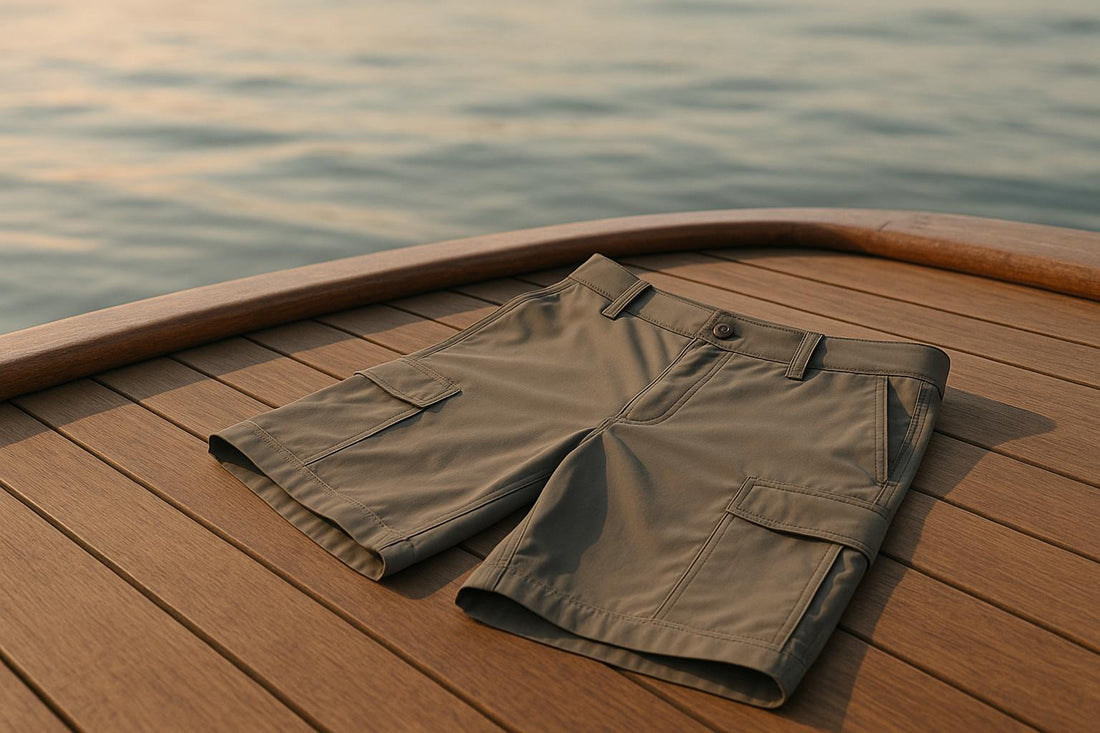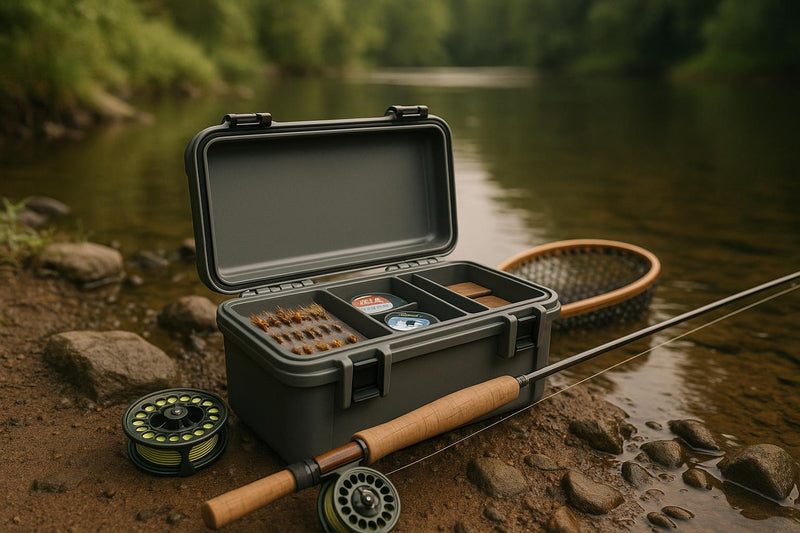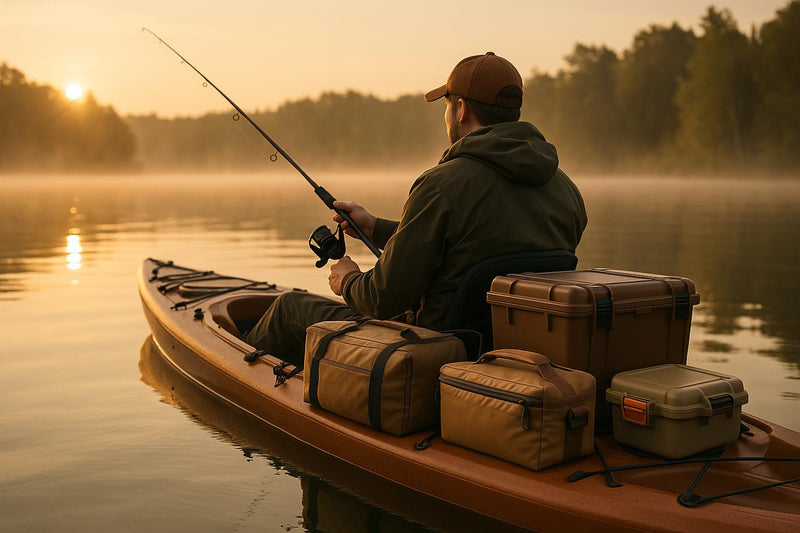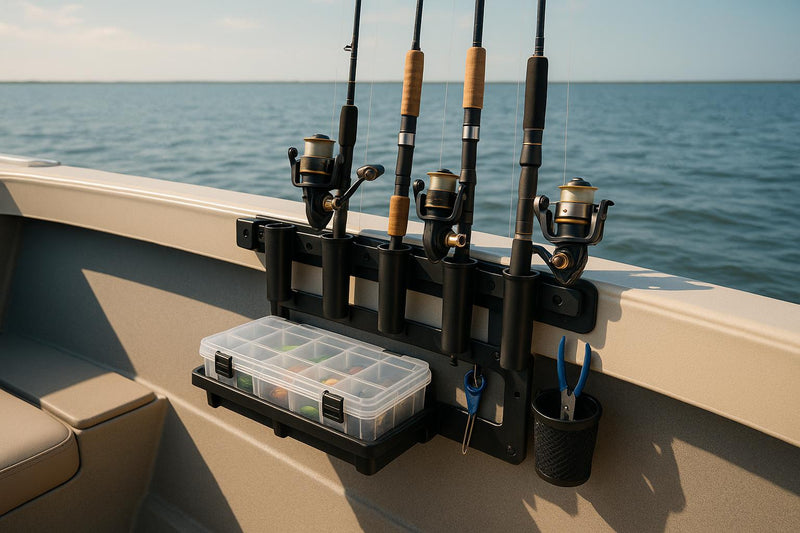Fishing shorts are more than just apparel - they're your first line of defense against discomfort and wear during long hours on the water. Choosing the right material is crucial to staying dry, comfortable, and protected. Here's what you need to know:
- Nylon: Lightweight, durable, and quick-drying. Perfect for handling abrasions and wet conditions.
- Polyester: Moisture-wicking, strong, and offers UV protection. Dries faster than most materials, making it ideal for hot, sunny days.
- Spandex Blends: Adds stretch and flexibility to other fabrics, ensuring freedom of movement. Great for active fishing sessions.
- Cotton: Soft and breathable but absorbs water and dries slowly. Best for casual, dry-weather fishing.
For serious anglers, synthetic materials like nylon and polyester dominate due to their durability, moisture management, and quick-drying properties. Spandex blends offer unmatched mobility, while cotton is better suited for relaxed outings.
Reel Comfort's fishing shorts combine these advanced materials with features like removable thigh pads, water resistance, and reinforced stitching for $59.99. Designed for performance, they’re available in black, gray, and blue to suit various fishing environments.
Quick Comparison:
| Material | Durability | Water Resistance | Mobility | Drying Speed | Best Use |
|---|---|---|---|---|---|
| Nylon | High | High | Moderate | Fast | All-purpose fishing |
| Polyester | Very High | Excellent | Moderate | Very Fast | Long trips, wet conditions |
| Spandex Blends | Depends on base | Good (if blended) | Excellent | Fast (if blended) | Active fishing, high mobility |
| Cotton | Low | Poor | High (when dry) | Very Slow | Casual, dry-weather fishing |
Your choice depends on your fishing conditions, activity level, and need for durability or flexibility. Nylon and polyester are top picks for performance, while spandex blends excel in mobility, and cotton is best for comfort in dry conditions.
1. Nylon
Nylon is a go-to fabric for fishing shorts, offering a combination of strength, durability, and lightness that’s hard to beat. This synthetic material is built to handle the challenges of fishing, making it a favorite for anglers who need gear that performs under tough conditions. Its lightweight nature and high tensile strength ensure it can keep up with the demands of a day on the water.
When it comes to staying dry, nylon shines. It wicks moisture away from your skin and dries quickly, making it perfect for battling spray, rain, or humid weather. Unlike natural fibers, nylon doesn’t soak up water; instead, it lets moisture evaporate swiftly, keeping you comfortable and focused on your fishing.
Nylon’s toughness is another big plus. It resists abrasions and stands up to the wear and tear of fishing activities. Whether you’re leaning against boat rails, walking on rough decks, or handling sharp hooks and tackle, nylon’s durable fibers protect against rips and punctures. Plus, its elasticity helps it bounce back after stretching, so it stays in shape even after a long day of use.
For anglers looking for extra comfort, nylon pairs well with advanced padding systems. Its flexibility ensures that padded inserts move naturally with your body, making it a great match for premium Men’s Fishing Shorts that feature removable thigh pads for added support during long fishing sessions.
Many modern nylon fishing shorts also include a touch of spandex for enhanced stretch and mobility. This blend allows the fabric to move with you seamlessly, whether you’re casting, reeling, or just moving around the boat. At the same time, it retains nylon’s standout features - durability and quick-drying performance.
With its mix of resilience, comfort, and practicality, nylon stands out as a top choice for fishing gear. Products like the Fishing Shorts from Reel Comfort showcase how this material can be combined with ergonomic designs to meet the needs of serious anglers.
2. Polyester
Polyester makes up a whopping 54% of global fiber production. Its durability, moisture management, and versatility have solidified its place in high-performance fishing gear. Let’s take a closer look at why polyester is such a game-changer for anglers.
One of polyester’s standout features is its moisture-wicking ability, which outshines natural fibers like cotton. Cybil Jones from Dagon Apparel Company explains:
"Polyester doesn't let your body stay covered in sweat; it drains all the sweat from your body to the upper layer of the shirt, where it easily evaporates."
This means the fabric pulls moisture away from your skin, allowing it to evaporate quickly. For anglers spending hours under the blazing sun, this translates to staying cooler and more comfortable, even in intense heat. Plus, polyester’s quick-drying nature prevents the annoyance of wearing sweat-soaked clothing.
Another major advantage is durability. As noted by the Apex Mills Blog:
"Polyester fibers are significantly stronger than natural fibers. Polyester resists tearing, stretching, and abrasion."
This resilience makes polyester fishing gear tough enough to handle the wear and tear of long days on the water - whether you’re leaning against boat rails, kneeling on abrasive surfaces, or dealing with sharp fishing tackle.
Polyester also offers excellent sun protection. With UPF50+ ratings, polyester garments can block up to 98.5% of harmful UV rays. This is a crucial feature for anglers exposed to the sun for extended periods. And because polyester dries so quickly, it regains its full UPF protection faster after getting wet.
The material’s flexibility and shape retention add another layer of functionality. Polyester can be engineered for elasticity, making it ideal for fishing shorts with protective padding or removable thigh inserts. This ensures both comfort and mobility during demanding activities.
Polyester’s versatility is another reason it dominates fishing gear. It’s often blended with materials like spandex to create fabrics tailored for specific needs - whether that’s added stretch, improved water resistance, or enhanced breathability. Manufacturers can fine-tune these blends to meet the demands of different fishing scenarios.
On top of all this, polyester is easy to care for. It’s wrinkle-resistant, simple to clean, and doesn’t require much maintenance. Just skip the fabric softeners to preserve its moisture-wicking properties.
For anglers debating between everyday clothing and specialized gear, polyester’s technical features make it clear why it’s the go-to choice for marine environments. Its performance on the water is hard to beat.
3. Spandex/Elastane Blends
Spandex/elastane blends, when combined with polyester, create a winning formula for anglers who demand comfort and freedom of movement without compromising durability. These blends bring unmatched stretch and flexibility, making them ideal for active fishing sessions where mobility is key.
Elastane has the remarkable ability to stretch up to 600% of its original length, which means even a small percentage (typically 2–5%) can dramatically enhance a fabric's flexibility. In most fishing shorts, you'll find blends of around 85–90% polyester and 10–15% spandex. This combination strikes a perfect balance: polyester provides strength and moisture-wicking properties, while spandex ensures the fabric moves with you, offering a snug yet adaptive fit. Together, they create a fabric that not only stretches but also supports, making every movement - from casting to crouching - effortless.
The benefits of these blends are immediately apparent on the water. Whether you're bending to grab your tackle box, kneeling to reel in a catch, or stretching to reach a storage compartment, the fabric moves with you seamlessly. Spandex eliminates the restrictive feel of stiffer materials, ensuring you stay comfortable and unrestricted throughout the day.
But it’s not just about flexibility. Spandex blends also excel in moisture management and durability. When paired with polyester or nylon, elastane enhances the fabric's ability to wick away sweat while maintaining a lightweight, smooth feel - even during long fishing trips. Plus, these blends resist sagging and retain their shape, even after repeated wear and washing, ensuring your fishing shorts hold up season after season.
That said, there is one trade-off to consider: spandex blends can retain more heat than other materials, making them less ideal for extremely hot climates. However, many anglers find the added comfort and mobility well worth it, particularly in moderate conditions where sun and wind protection are equally important.
Another standout feature of spandex blends is their compatibility with padded fishing shorts. The stretchiness of elastane allows padding to conform closely to your body, ensuring a secure and comfortable fit that stays in place even during high-activity moments. This makes them an excellent choice for anglers who prioritize both protection and mobility.
Anglers frequently praise the comfort and practicality of spandex blends. Stretch waistbands, in particular, are a favorite among older anglers, offering a forgiving fit that eliminates discomfort and pressure points during long days on the water. Additionally, the generous cut of many designs provides extra room for movement, further enhancing their appeal.
For those looking for fishing shorts that combine performance, durability, and all-day comfort, spandex blends are a standout choice. Paired with ergonomic padding systems, they deliver the flexibility and protection needed for active fishing adventures. Explore the difference with our Mens Fishing Shorts.
4. Cotton
After diving into synthetic materials, let's shift gears to cotton - a natural option that prioritizes comfort over technical performance. While synthetic fabrics dominate modern fishing gear, cotton still finds its niche in specific fishing scenarios.
One of cotton's standout qualities is its softness and breathability. Cotton expert Janice Person highlights this advantage:
"Cotton tends to be more breathable due to its naturally porous structure whereas polyester is."
This natural breathability makes cotton fishing shorts a great choice for mild-weather outings, as the fabric allows air to circulate and keeps you cool. Plus, cotton's hypoallergenic nature can be a relief for anglers with sensitive skin.
However, cotton has its downsides, especially in wet environments. Its high absorbency - holding up to 27 times its weight in water - can leave your shorts damp and prone to chafing. Beyond that, cotton fibers don't hold up as well as synthetics when exposed to saltwater, UV rays, and frequent washing. Over time, this can cause the material to degrade faster. And let’s not forget shrinkage - pure cotton garments can shrink 2–5%, which might affect the fit of your gear .
Another drawback is padding. In cotton shorts, padding can shift when the fabric absorbs moisture. While using chamois cream can help reduce friction, it's not a perfect solution.
On the plus side, cotton is budget-friendly, making it appealing for casual anglers. That said, its lack of quick-drying and moisture-wicking properties limits its usefulness in demanding marine settings. If you prefer natural fabrics but need better performance, cotton blends with moisture-wicking synthetics might strike a balance. Still, pure cotton is better suited for relaxed, shore-based fishing trips rather than intense angling adventures.
In short, cotton works best for short, dry-weather outings where comfort and affordability take priority. For more durable options designed to handle all conditions, check out our Fishing shorts.
sbb-itb-cb0a783
Pros and Cons
When it comes to fishing gear, the choice of material can significantly affect your comfort and the protection of your equipment. Here's a closer look at how the most common materials for fishing shorts measure up in the areas that matter most to anglers.
| Material | Durability | Water Resistance | Comfort & Mobility | Quick-Dry Performance | Best For |
|---|---|---|---|---|---|
| Nylon | Handles abrasion exceptionally well; performs reliably in marine environments | High water resistance with added UPF protection | Comfortable, especially in blends with spandex | Dries quickly | Great for versatile fishing on boats or shorelines |
| Polyester | Extremely durable, resists stains and wrinkles | Excellent water resistance and UPF protection | Offers moderate comfort, improved in stretch blends | Dries the fastest among these options | Ideal for long trips and wet conditions |
| Spandex/Elastane Blends | Durability depends on the base material (nylon or polyester) | Inherits water resistance from the base fabric | Highly flexible, allowing a full range of motion | Quick-drying when blended effectively | Perfect for active fishing requiring mobility |
| Cotton | Less durable in rough marine conditions | Minimal water resistance | Soft and breathable when dry, but uncomfortable when wet | Slow to dry | Best for casual shore fishing in mild, dry weather |
Each material has its strengths and weaknesses, making them suitable for different fishing conditions.
Polyester stands out for its durability, excellent water resistance, and the fastest drying time, making it a top choice for extended trips or fishing in wet environments. Want to learn more about how quick-dry fabrics work? Check out our guide on quick-dry fabric technology.
Spandex blends, on the other hand, are all about flexibility. They enhance mobility, making them perfect for anglers who need to stay active and agile on the water.
Nylon offers a balance of abrasion resistance and water management, making it a versatile option for both freshwater and saltwater fishing. It's a reliable choice for those who need gear that can handle a variety of environments.
Cotton, while soft and breathable when dry, struggles with water resistance and drying speed. As a result, it's better suited for recreational fishing in calm, dry weather.
For anglers prioritizing water resistance, our guide on water-resistant gear protection dives into why this feature is essential for long-term performance.
Interestingly, many anglers prefer nylon-spandex blends, which combine durability, water resistance, and mobility for a well-rounded performance in various fishing scenarios. Curious about how these materials stack up in specialized gear? Check out our detailed comparison of padded fishing shorts versus regular shorts.
When deciding on fishing shorts, think about your typical fishing conditions, trip length, and how much movement your activities require. The right material can make all the difference between an enjoyable day on the water and an uncomfortable one.
Reel Comfort's Premium Fishing Shorts
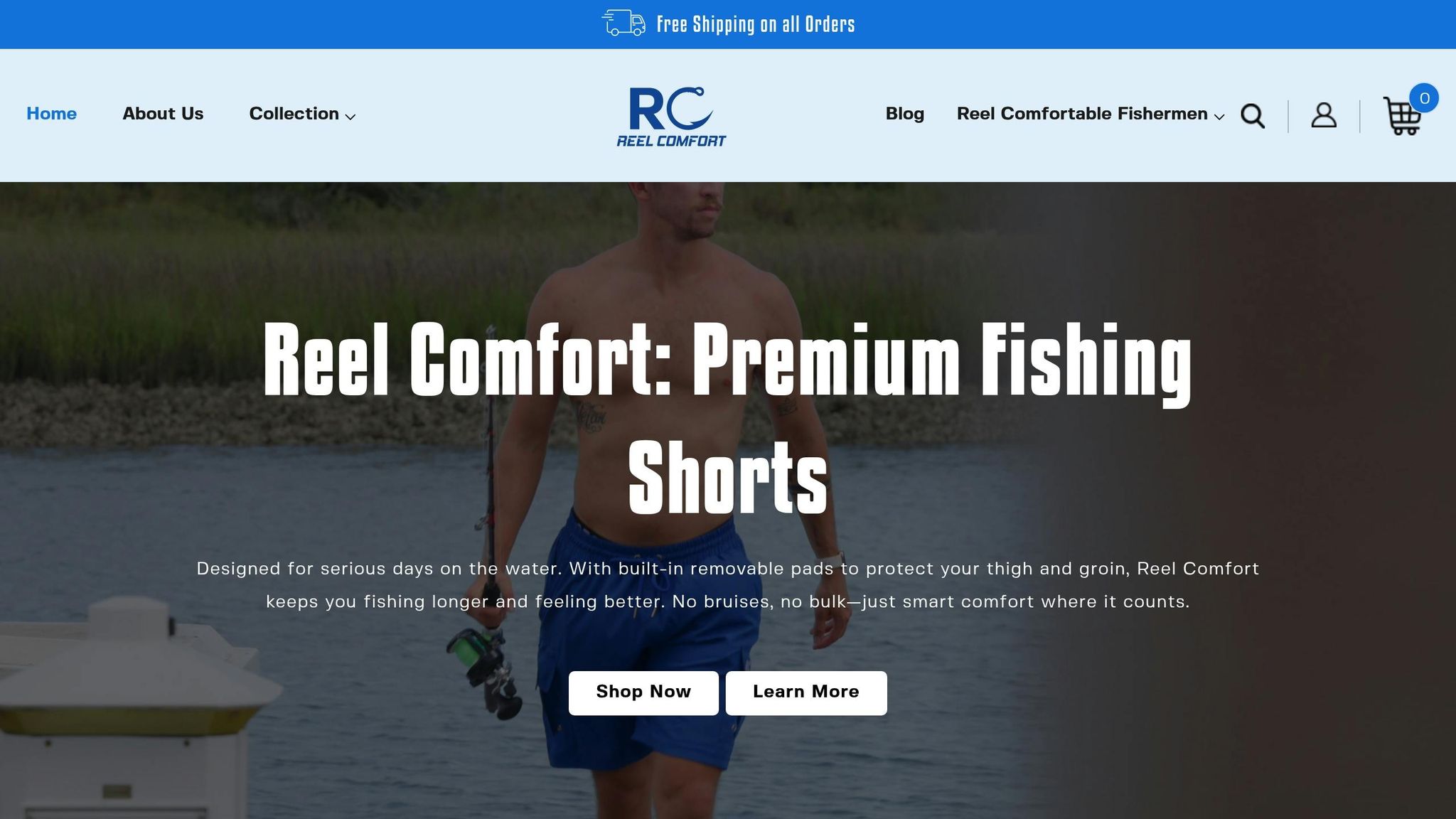
Reel Comfort has crafted their fishing shorts with a smart blend of advanced materials, designed to tackle the challenges anglers face on the water. At $59.99, these shorts combine comfort, durability, and functionality, making them a reliable choice for fishing enthusiasts.
The shorts are built with a lightweight, quick-dry fabric featuring a water-resistant finish. This special coating causes water to bead up and roll off instead of soaking in, ensuring you stay dry and comfortable during long fishing trips. Unlike cotton, which can take ages to dry, this fabric dries in just 10–30 minutes. Whether you're dealing with wave spray or an unexpected splash, you won’t have to endure soggy shorts for hours. The water-resistant finish ensures the drying process starts immediately, keeping you focused on fishing instead of your gear.
Freedom of movement is another key feature. Four-way stretch panels allow for unrestricted mobility, so you can crouch, cast, or climb without any discomfort. These stretch panels work seamlessly with the quick-dry fabric, giving you a combination of flexibility and performance that’s hard to beat.
Durability is a top priority, too. Reinforced stitching and rip-stop construction make these shorts tough enough for any fishing adventure. For added functionality, they come with removable neoprene thigh pads, securely held in place by velcro-lined pockets. These pads provide a cushioned surface for resting your rod, protecting your thigh and groin area from rod pressure. They also ensure stability, so the rod stays put even during active fishing.
Anglers across the U.S. have shared glowing reviews of these shorts in real-world conditions. Jason M., a Florida bass angler, noted:
"These shorts let me rest my rod on my thigh without scraping up the handle. It makes a huge difference when tying knots while standing in my kayak. The quality and price are huge perks, too."
Reggie K., a saltwater fishing enthusiast, praised the rail protection feature:
"No more leaning my rod on the boat rail or risking it slipping into the water. Just lean it on the pad, and it stays put - good for any fishing trip!"
Tournament angler Carlos R. appreciated the simplicity and functionality:
"I love how simple it is. The pads are soft but hold the rod steady - no extra contraptions needed and built to last."
These shorts are designed to handle diverse fishing environments across the U.S. Whether you're navigating Florida's humid saltwater conditions or fishing in the cooler freshwater lakes up north, the combination of durable fabrics and innovative padding offers comfort and protection. Available in black, gray, and blue, they’re a perfect blend of style and practicality.
Upgrade your fishing experience with high-performance fishing shorts and see the difference for yourself.
Conclusion
Picking the right material for your fishing shorts can make or break your day on the water. Whether it’s the toughness of nylon, the quick-drying ability of polyester, the stretch of spandex blends, or the casual comfort of cotton, each material serves a unique purpose depending on your fishing conditions.
As highlighted earlier, combining the right materials ensures you stay comfortable, protected, and ready for whatever the day brings. Features like strategic padding and smart construction add an extra layer of comfort and durability, making a big difference during long fishing trips across the United States.
Reel Comfort’s fishing shorts embody these qualities with their high-performance design. Priced at $59.99, they’re crafted from lightweight, quick-drying fabric with a water-resistant coating, four-way stretch panels, reinforced stitching, and durable rip-stop construction. The removable thigh pads offer essential rail protection, creating a stable and cushioned surface for resting your rod during extended hours on the water.
Available in black, gray, and blue, these men’s fishing shorts combine advanced materials with thoughtful design, delivering reliable performance in any fishing environment.
Experience the difference with our fishing shorts today.
FAQs
What makes nylon a great material for fishing shorts?
Nylon is a solid pick for fishing shorts thanks to its water resistance, quick-drying abilities, and long-lasting durability. This material is tough enough to handle abrasions and the wear-and-tear of active fishing adventures. Plus, nylon holds up well over time - it resists fading and shrinking, so your shorts will keep their look even after many outings. These qualities make nylon a reliable choice for staying comfortable and prepared during extended fishing trips.
Why are spandex blends a great choice for fishing shorts?
Spandex blends are a fantastic option for fishing shorts thanks to their 4-way stretch feature, which offers excellent flexibility and unrestricted movement. This comes in handy during activities like casting, reeling, or bending - especially on those long fishing trips.
These materials are designed to be lightweight, quick-drying, and tough enough to handle wet, active conditions. Plus, their ability to adapt to your movements ensures you stay comfortable all day, whether you're out on the boat or standing waist-deep in the water.
Why isn’t cotton the best choice for fishing shorts in wet conditions?
Cotton isn't the best choice for fishing shorts, especially in wet conditions. It soaks up water quickly, turning heavy and uncomfortable. Plus, it takes forever to dry, leaving you damp for longer periods and increasing the chance of chafing - a real issue during extended fishing trips.
Instead, opt for shorts made from quick-drying synthetic materials or water-resistant fabrics. These options provide better comfort, allow for easier movement, and are built to last, helping you stay dry and focused on reeling in your next catch.

